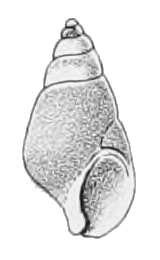Hinea brasiliana facts for kids
Quick facts for kids Hinea brasiliana |
|
|---|---|
 |
|
| An apertural view of a shell of Hinea brasiliana. | |
| Scientific classification | |
| Kingdom: | |
| Phylum: | |
| Class: | |
| (unranked): |
clade Caenogastropoda
clade Sorbeoconcha |
| Superfamily: |
Cerithioidea
|
| Family: |
Planaxidae
|
| Subfamily: |
Planaxinae
|
| Genus: | |
| Species: |
H. brasiliana
|
| Binomial name | |
| Hinea brasiliana (Lamarck, 1822)
|
|
| Synonyms | |
|
|
The Hinea brasiliana, also known as the yellow-coated clusterwink, is a small sea snail. It's a type of gastropod mollusc that belongs to the Planaxidae family. You can find this snail living on rocky shores in New Zealand and southeastern Australia. What makes it really special is that it's one of the few sea snails that can actually make its own light, a process called bioluminescence.
Contents
About the Yellow-Coated Clusterwink
Its Scientific Name
This snail was first described in 1822 by a scientist named Jean-Baptiste de Lamarck. He gave it the name Buccinum brasilianum. Lamarck thought the snail came from Brazil, which is why he used "brasiliana" in its name. But it turns out, the snail doesn't live there at all! Later, another scientist, John Edward Gray, moved this snail to a new group called Hinea.
What It Looks Like
The shell of the Hinea brasiliana is quite strong and heavy. It can grow to be about 21 millimeters (about 0.8 inches) long. The shell is shaped like a narrow cone. It can be smooth or have small grooves that go around it in spirals. These spirals are called whorls.
The opening of the shell, called the aperture, is small. It's partly closed off by a thick part called a callus and the central part, the columella. The edge of the opening is thin, but the shell quickly gets thicker behind it. This thicker part has weak raised lines called lirae.
The snail also has a hard, horny "door" called an operculum. This operculum closes the shell tightly when the snail pulls itself inside. The shell is white both inside and out. When the snail is young, its shell is covered by a yellowish-brown layer called a periostracum, but this layer wears off over time.
Where It Lives
In Australia, the Hinea brasiliana lives along the coast from Queensland down to South Australia. In New Zealand, you can find it on the North Island. It also lives on other islands like Lord Howe Island, Norfolk Island, and the Kermadec Islands.
These snails live in the middle part of rocky shores, where the ocean meets the land. They like to hide among rocks and rubble. They prefer places where the waves are strong, but they avoid the most open spots with very big waves. They are so common in Australia that their empty shells make up a lot of the shell pieces you find on beaches!
Life and Behavior
Daily Life
When the ocean tide goes out, these snails often gather together in wet spots. They hide in cracks in rocks or under them to stay safe and moist. As soon as the tide comes back in, they spread out. They then graze on tiny algae that grow on the rocks.
Reproduction
Like other snails in the Planaxidae family, Hinea brasiliana has internal fertilization. This means the eggs are fertilized inside the female snail. The tiny snail babies, called embryos, grow in a special chamber behind the female's head. Once they are ready, they are released into the sea as veliger larvae. These larvae float around in the water as part of the plankton before they settle down and grow into adult snails.
How It Makes Light
When the Hinea brasiliana snail is bothered, it can flash bluish-green light. If something hits it quickly, it flashes even brighter! This light comes from a soft part of its body called the mantle. The light shines through its pale, see-through shell. The shell actually helps to spread the light, making the whole snail glow.
Scientists think this light helps to scare or surprise things that might want to eat the snail, like a crab. The snail can flash its light while staying safe inside its shell. It's been found that the shell is especially good at spreading this blue-green light, making the snail seem bigger than it really is. This light diffusion through the shell is even better than some special materials made by humans!
Besides scaring away an attacker, the light might also have another clever use. It could attract a bigger animal to eat the crab that is bothering the snail. This is sometimes called the "burglar alarm" effect.
- Ponder W. F. (1988). "Bioluminescence in Hinea braziliana (Lamarck) (Gastropoda, Planaxidae)". Journal of Molluscan Studies 54(3): 361. .
See also
 In Spanish: Hinea brasiliana para niños
In Spanish: Hinea brasiliana para niños

